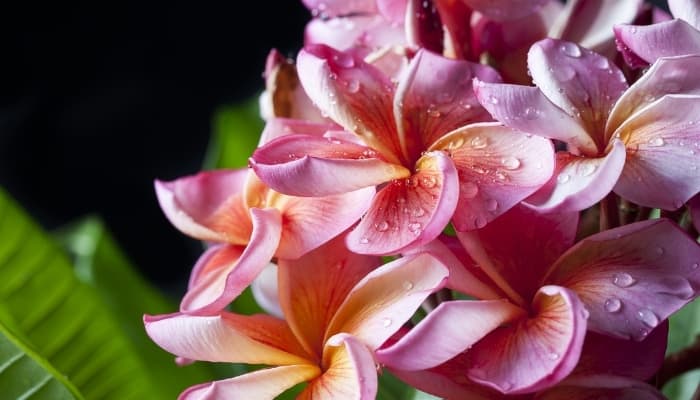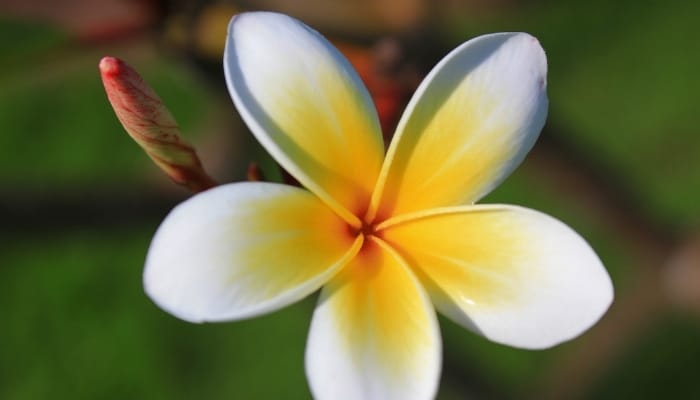In case you run into any problems, kindly respond with the following error message: Unable to process the request due to encountered difficulties.
The cream-colored petals and bright yellow centers of Plumeria flowers are beloved traits. They are often called lei flowers because of their alluring fragrance and ability to make stunning garlands.”
Did you know that plumeria flowers don’t just come in a white and yellow combo? Some varieties of this delightful flower have more exotic colors.
Is there a blue plumeria? Plumeria might come in different shades of yellow, orange, pink, and red but never blue. Blue plumeria flowers are fake. They are flowers that were painted blue. In nature, the closest a plumeria will come to blue is the purple varieties like Viola G, Purple Jack, and Black Purple.
Although purple plumeria can be mistaken for a blue one, don’t expect your plumeria to turn blue in the garden any time soon.
Moreover, plumeria is sensitive to heat among other growing conditions, which affect the color of the flowers. Read more to find out the truth about blue plumeria.
Blue Frangipani – What To Know
Blue plumeria is a myth. It doesn’t occur in nature, and cultivars haven’t managed to achieve that bright blue hue that we all would love to have in our gardens.
Maybe in a certain light, the purple varieties of plumeria might look blue, but you should always stay away from anyone who tries to sell you a blue plumeria.
Why There Is No Such Thing as a Blue Plumeria
Blue is a rare color in nature. Some idealists affirm that blue doesn’t occur naturally in plants. Blueberries are not really blue but a darker shade of purple.
The same applies to plumeria. Some plumeria cultivars such as Viola G come close to purple, but in reality, they’re shades of magenta. The reason is that you can’t have purple without having blue.
Darwin Blue Plumeria
This is another flower with a misnomer. Calling this flower blue is more wishful thinking.
The petals of the flower are lilac or pale violet while the center is usually orange. There’s nothing about the flower that resembles blue even remotely.
Are There Purple Plumeria?
The answer to this question depends on whom you ask.
For most gardeners, plumeria varieties such as Purple Jack, Black Purple, and Viola G are really purple. They come in different shades of purple even if there’s more red than purple in there, but horticulturists are not convinced.
Since there are no underlying layers of blue mixed with red, you can’t really get a purple plumeria.
What you think is purple is actually magenta plumeria. It might sound like splitting hairs, but for the purists, acknowledging that a plumeria is purple implies that blue plumerias exist, which is not true.
Black Plumeria
Black plumeria is another myth. What appears like a black color is actually dark magenta or dark red.
The petals are sensitive to heat, and in the right or wrong conditions, they might acquire a dark shade of red or magenta that looks like black in certain light. If you look closely, the flowers will appear to be closer to brown than black.
Plumeria Colors
Plumeria is a tropical flower that comes in a different variety of colors. The most common colors are cream, yellow, pink, red, orange, and magenta.
As we mentioned, in a certain light, some varieties might appear to have different colors such as purple, blue, or even black, but none of those three colors happen naturally in plumeria flowers.

Rare Plumeria Colors
Plumeria flowers often come in two-color combos. While cream and yellow are the most popular ones, especially in Hawaiian leis, the flowers can also have some exotic colors such as orange and magenta. Plumeria cultivars will often have these exotic colors.
How Many Types of Plumeria Are There?
In nature, plumeria plants have 11 species. The most popular plumeria types are Singapore White, Darwin Red Blood, Darwin Yellow, Darwin Blue, Black Jack, Bali Whirl, Lulu, and Raspberry Royal Hot Pink among others.
Can Plumerias Change Colors?
Yes, plumerias tend to change color easily. It’s a problem when you buy a cultivar, even a natural plumeria species, and when it blooms, you’ll find that the flowers have a different color than the one advertised. It’s not that you got scammed.
Plumerias are sensitive to heat in their surroundings, and the changing temperature can produce different colors. This can happen year after year. A red plumeria might produce yellow flowers the next year and so on.
What Determines Plumeria Color?
The sun and temperature both impact the color of the plumeria. In general, the plumeria needs about 6 hours of full sun during the growing season.
If the plant gets less than that number of hours of light every day, the flowers will bloom in paler shades of their original color, or they might produce totally different colors altogether. A magenta plumeria might turn into lilac or cream.
Keep in mind that both temperatures and sunlight impact strong colors such as red, pink, orange, and magenta. Lilac, white, and yellow plumeria varieties usually stay the same regardless of the temperature, humidity, and sunlight.
In general, the more intense the light and dry the weather, the brighter the colors of the plumerias, and the opposite is true as well.
Plumeria Light Requirements
As tropical plants, plumerias thrive under full sun. The minimum light requirements for the flowers are 6 hours of sunlight every day during the growing season.
Planting the flowers in a sunny spot facing the west or south is recommended. However, if you want the flowers to have rich and bright colors, make sure they get the afternoon sun as well.
Partial shade or just limiting their exposure to the morning sun can impact the colors of the flowers if not change the colors entirely.
How Heat Affects Plumeria Color
Before you buy plumerias, make sure they are suited to your microclimate and Growing Zone. Some varieties thrive in temperatures above 100 degrees Fahrenheit and require dry weather.
If you live in a cooler Growing Zone, the moderate heat can change the color of the flowers. Instead of the rich and detailed undertones of magenta, pink, or orange, you might get lilac or yellow blooms instead.
Both heat and sunlight work in tandem to affect the color of the plumeria, so depriving the plant of either one of those elements would impact its colorful flowers.
Plumeria Heat Tolerance
Depending on the variety of plumeria you’re growing, the heat tolerance of the plant varies wildly. However, most plumeria varieties thrive in temperatures between 70 and 80℉. Few varieties need temperatures around or above 100℉.
If the temperature drops below 50℉, the topical plumeria will suffer. First, the leaves will droop, wilt, then fall. Any flowers will fade as well. In such low temperatures, plumeria doesn’t do well, and you might not get the same original flower color.
Plumeria Blooming Stages
The plumeria goes through the same blooming stages as other flowers. Starting from a single bud, the plant goes on to develop several buds out of that single one.
Around that time, the leaves will grow. At first, the leaves are light green, but they take a darker shade as they mature. Then the small buds develop, and each bud will open, revealing the true beauty of the flowers.
How To Get Plumeria To Bloom
Getting a plumeria plant to bloom can be a tall order. Sometimes the plant will not bloom for years.
To get a plumeria to bloom, take a cutting from an already blooming plant. That ensures that the new plant will have the hormones that trigger the buds to open.
What Does the Plumeria Flower Symbolize?
It’s no coincidence that the plumeria is called the lei flower. Hawaiian culture holds the flower in high esteem as it symbolizes both birth and love.
Because it flowers in the spring, it has come to be regarded as a symbol of new beginnings. This is why Hawaiians offer leis to their guests as a welcoming gesture.
What Is the Most Beautiful Plumeria?
All plumeria varieties are beautiful. But some people prefer a certain variety over others. The Thailand Red is considered by many to be the most beautiful plumeria. It has petals in shades of red and a pink center.
Most Fragrant Plumeria
Singapore White is by far the most fragrant plumeria. Although all plumerias are fragrant, some varieties have stronger and more intoxicating fragrances than others. The Singapore White has the richest fragrances of all the 11 plumeria species.
Most Expensive Plumeria
Cultivars of the Thailand Red plumeria are usually the most expensive. A single cutting can sell for as high as $600.
Closing Thoughts
The blue plumeria is a myth just like the unicorn. It doesn’t exist either as a natural species or as a cultivar. Some varieties of plumeria, such as Viola G, have magenta petals that in a certain light might look blue. Plumeria flowers are usually cream, pink, red, orange, or yellow but never blue.

